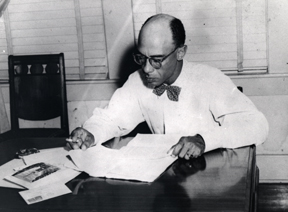H.M. Sweatt
Sweatt v. Painter
On February 26, 1946, Heman Marion Sweatt, an American of African descent, was denied admission to the University of Texas School of Law, as state law required segregation by race. The Court of Civil Appeals would later write that “he possessed every essential qualification for admission, except that of race, upon which ground alone his application was denied.”
Heman Marion Sweatt
CN02732, Craft (Juanita Jewel Shanks)
Collection, Center for American History
Mr. Sweatt filed a lawsuit in Travis County against UT President T.S. Painter on May 16, 1946. Judge Roy C. Archer of the 126th District Court, recognizing that the State had no “separate but equal” facility for a law school, gave the State of Texas six months to “establish a law school for Negroes substantially equivalent” to the University of Texas School of Law, and officials of the University of Texas complied. Judge Archer concluded that the new school offered the petitioner “privileges, advantages, and opportunities for the study of law substantially equivalent at the University of Texas.”
Mr. Sweatt’s legal team appealed the decision, and ultimately, in 1950, the Supreme Court of the United States disagreed with the lower court. While not yet denouncing “separate but equal” as the constitutional policy of the United States, the Court wisely saw beyond the bricks and books that make a school and concluded that separate professional schools were inherently unequal. Sweatt laid the groundwork for the Court’s decision in 1954’s Brown v. Board of Education of Topeka. In Brown, the Court finally concluded that, although the physical facilities may be equal, segregation of children in public schools solely on the basis of race deprives the children of equal education opportunities. Sweatt gave the court the logic that enabled it to strike down segregation as the law of the land by providing an interim step in the process of legal analysis. It is not an overstatement to say that Sweatt v. Painter began the process of desegregating America’s schools.[1]
[1] The Heman Marion Sweatt Travis County Courthouse, Austin, Texas: A Historical Perspective (Austin, Texas, 2008). A copy of this brochure can be obtained at the Travis County Courthouse.



